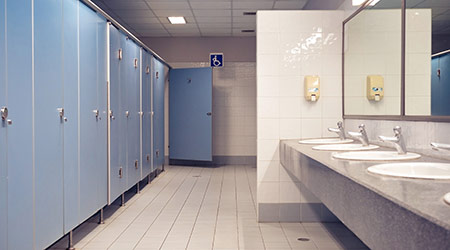
When it comes to landing repeat business, having a well-maintained restroom is vital. If someone's touch, smell, or sight senses something is awry, that individual is remarkably less likely to visit that restroom again, or, consequently, that entire facility.
Facility cleaning managers know this, which is why they place so much focus on keeping restrooms full of soap and towels and free of the stick and stink.
Unfortunately, the effectiveness of this extra attention is all too often thwarted by employees who lack the education necessary to properly carry out their job. The best way to solve this issue is to identify problem areas within the restroom and then treat them with textbook cleaning methods.
Most building occupants have encountered something so visually unpleasant in the restroom that it makes their stomach churn, but when it comes to upsetting visitors, it's foul odors that most often cause discomfort, says Carol Dell'Aquila, vice president of sales at Maintex, City of Industry, California. To rectify a stench, some facilities will use fragrances intended to mask or cover the smell. However, the blend of a scent, like apples, for example, is never going to mesh well with the stench of bacteria or bodily fluids. Instead, Dell'Aquila recommends crews target the areas within the restroom that cause the bad smells, which might also solve visual issues.
Where We Touch
It's the last area a person visits when in the restroom, but the sink and hand-drying space is certainly not the least important. Its role as the area that rids hands of bacteria and bodily fluids cannot be understated. When people fail to use this area correctly, or are met with sinks, faucets and towels that themselves are dirty, they carry those germs with them throughout a facility, potentially sickening other building occupants.
If they could have their way, experts say all restrooms would feature touch-free fixtures because these appliances minimize the amount of contact hands have with high-touch surfaces. Unfortunately, not all restrooms possess touch-free technology. That's why cleaning faucets and any other high-touch surfaces is a top priority in sink and towel or hand dryer maintenance.
Like with many high-touch spots, a common mistake made when cleaning the sink area is not cleaning away dirt and grime well enough before disinfecting. When that first step of wiping away debris is carried out, it's all too common that workers are not getting these areas wet enough during disinfection to reach proper dwell times.
"I've been doing this for 41 years," says Dell'Aquila. "People don't allow the proper dwell time — I don't care who they are."
To properly disinfect the faucet, sink and hand drying area, one should should kill germs using disinfectant suitable for this space, says Jim White, director of sales at Dalco Enterprises, St. Paul, Minnesota. When choosing the disinfectant, consider manufacturer recommendations for surface applications and appropriate kill claims.
One the proper disinfectant is determined, the degree to which these spots must be cleaned varies by facility type. At an airport, for example, staff should be cleaning and disinfecting the sink area of a high-traffic restroom multiple times a day. In a more common commercial facility like an office, White suggests caring for restrooms once a day and touch up when nearby.
"Any time a custodian is in the restroom, they should use something as simple as a disinfectant wipe to tackle high-touch surfaces," says White.
Opinions can differ on whether a hand dryer or towel dispenser is the best option for drying hands. As a result, the problem hand drying areas face can also differ. Bacteria can accumulate in restrooms that only offer manual towel dispensers because of the contact hands have with the dispenser, says Keith Schneringer, director of channel marketing and sustainability at Waxie Sanitary Supply, San Diego. That's because, not only are hands touching the levers used to push out the product, but they're also wet, which attracts germs.
"That's like a breeding ground for bacteria," says Schneringer.
To solve this issue, crews should properly and consistently clean and disinfect towel dispensers. And regardless of whether the dispensers is or isn't near the door where people exit, the crews should make sure that there is some type of receptacle near the door where the towels can be thrown out. That's because many germ-conscious people use the towel they washed their hands with to open the doors they exit, and if there's no dispenser there, many will throw their damp, soiled towels on the floor.
Germs are just as present, if not more so, around hand dryers. Schneringer says studies have shown that the bacteria count on a person's hands can actually be greater after they use a hand dryer than they were before. To better avoid this issue, he suggests changing out the filter of the hand dryer on a regular basis.
Eliminating Restroom Odors

 The Down and Dirty on Cleaning in Virus Season
The Down and Dirty on Cleaning in Virus Season How Surfactant Use is Expanding in Commercial Cleaning
How Surfactant Use is Expanding in Commercial Cleaning Operational Excellence Series 2025: Better Budgeting
Operational Excellence Series 2025: Better Budgeting